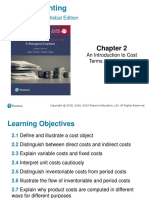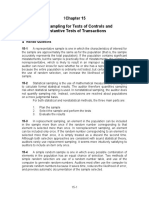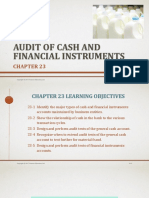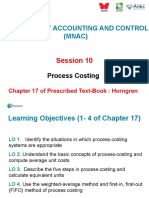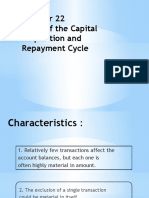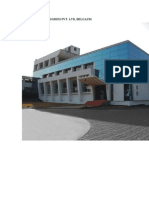0 ratings0% found this document useful (0 votes)
55 viewsArens - Aud16 - Inppt09 (Sesi 10)
Arens - Aud16 - Inppt09 (Sesi 10)
Uploaded by
Denisse Aretha LeeCopyright:
© All Rights Reserved
Available Formats
Download as PDF, TXT or read online from Scribd
Arens - Aud16 - Inppt09 (Sesi 10)
Arens - Aud16 - Inppt09 (Sesi 10)
Uploaded by
Denisse Aretha Lee0 ratings0% found this document useful (0 votes)
55 views44 pagesOriginal Title
arens_aud16_inppt09 (sesi 10)
Copyright
© © All Rights Reserved
Available Formats
PDF, TXT or read online from Scribd
Share this document
Did you find this document useful?
Is this content inappropriate?
Copyright:
© All Rights Reserved
Available Formats
Download as PDF, TXT or read online from Scribd
Download as pdf or txt
0 ratings0% found this document useful (0 votes)
55 views44 pagesArens - Aud16 - Inppt09 (Sesi 10)
Arens - Aud16 - Inppt09 (Sesi 10)
Uploaded by
Denisse Aretha LeeCopyright:
© All Rights Reserved
Available Formats
Download as PDF, TXT or read online from Scribd
Download as pdf or txt
You are on page 1of 44
ASSESSING
THE RISK OF
MATERIAL
MISSTATEMENT
CHAPTER 9
Copyright © 2017 Pearson Education, Ltd. 9-1
CHAPTER 9 LEARNING OBJECTIVES
9-1 Define risk in auditing.
9-2 Distinguish the different types of risk assessment procedures.
9-3 Understand important auditor considerations related to the risk of material
misstatement due to fraud.
9-4 Describe the auditor’s responsibility to identify significant risks.
9-5 Describe the audit risk model and its components.
9-6 Assess acceptable audit risk.
9-7 Consider the impact of several factors on the assessment of inherent risk.
9-8 Discuss the relationship of risk to audit evidence.
9-9 Discuss how materiality and risk are related and integrated into the audit
process.
Copyright © 2017 Pearson Education, Ltd. 9-2
OBJECTIVE 9-1
Define risk in auditing.
*AUDIT RISK is the risk that the auditor expresses an
inappropriate audit opinion when the financial statements are
materially misstated
**RISK OF MATERIAL MISSTATEMENTS- risiko bahwa laporan
keuangan mengandung salah saji material yang sebabkan oleh
fraud atau error sebelum dilaksanakan audit (prior to audit)
Copyright © 2017 Pearson Education, Ltd. 9-3
DEFINE RISK IN AUDITING
Auditors ACCEPT some level of risk or uncertainty in performing
audits
1. Risk of Material Misstatement at THE OVERALL FINANCIAL
STATEMENT LEVEL: Refers to the risks that relate pervasively
to the financial statements as a whole and potentially affect a
number of different transactions and accounts.
2. Risk of Material Misstatement at THE ASSERTION LEVEL:
a. Inherent risk—Susceptibility of an assertion to material
misstatement (timbulnya salah saji material ini dari sebuah asersi
tertentu)
b. Control risk—Risk that internal controls will not prevent or
detect material misstatement.
Copyright © 2017 Pearson Education, Ltd. 9-4
OBJECTIVE 9-2
Distinguish the different types
of risk assessment procedures.
Copyright © 2017 Pearson Education, Ltd. 9-5
RISK ASSESSMENT PROCEDURES
Risk assessment procedures/prosedur penilaian risiko
meliputi:
1. Inquiries of management and others within the entity
2. Analytical procedures
3. Observation and inspection
4. Discussion among engagement team members
5. Other risk assessment procedures
The role of risk assessment procedures is detailed in Figure 9-1.
Copyright © 2017 Pearson Education, Ltd. 9-6
Copyright © 2017 Pearson Education, Ltd. 9-7
OBJECTIVE 9-3
Understand important auditor
considerations related to the risk of
material misstatement due to fraud.
Copyright © 2017 Pearson Education, Ltd. 9-8
CONSIDERING FRAUD RISK
Risk assessment procedures include assessing the risk
of material misstatement DUE TO FRAUD OR ERROR.
The auditor’s consideration of fraud risk is made at both the
a. Financial statement level and
b. Assertion level for classes of transactions, account balances,
and presentation and disclosures.
Because several high-profile cases of financial statement fraud
involve misstatements in revenue recognition, auditing standards
require the auditor to presume that risks of fraud exist in revenue
recognition.
Copyright © 2017 Pearson Education, Ltd. 9-9
OBJECTIVE 9-4
Describe the auditor’s responsibility
to identify significant risks.
Copyright © 2017 Pearson Education, Ltd. 9-10
IDENTIFICATION OF SIGNIFICANT RISKS
Auditor must determine whether any of the risks identified are a
significant risk.
A SIGNIFICANT RISK* is any risk that the auditor deems to require
special attention:
1. Non-routine transactions, including related-party transactions,
often represent significant risk
2. Account balances or transactions that require estimates for
which significant measurement uncertainty exists also may
require more attention
All fraud risks are normally considered to be significant risks.
Copyright © 2017 Pearson Education, Ltd. 9-11
*SIGNIFICANT RISK
• Significant risks generally relate to judgemental matters
and significant non-routine transactions.
• Risks of material misstatement may be greater for
significant judgemental matters requiring accounting
estimates or revenue recognition and for assumptions
about the effects of future events (e.g. fair value) than for
ordinary transactions.
IN DETERMINING WHAT A SIGNIFICANT RISK IS THE AUDITOR
CONSIDERS A NUMBER OF MATTERS, INCLUDING THE FOLLOWING:
Whether the risk is a risk of fraud.
The likelihood of the occurrence of the risk.
Whether the risk is related to recent significant economic, accounting or
other developments and, therefore, requires specific attention.
The complexity of transactions that may give rise to the risk.
Whether the risk involves significant transactions with related parties.
The degree of subjectivity in the measurement of financial information
related to the risk.
Whether the risk involves significant transactions that are outside the
normal course of business for the entity, or that otherwise appear to be
unusual given the auditor’s understanding of the entity and its environment.
OBJECTIVE 9-5
Describe the audit risk model and
its components
Copyright © 2017 Pearson Education, Ltd. 9-14
AUDIT RISK MODEL
The risk of material misstatement at the ASSERTION LEVEL consists
of two components: inherent risk and control risk.
Auditors consider these risks by applying the AUDIT RISK MODEL
The relationship between the audit risk model and the understanding of
the client’s business and industry is shown in Figure 9-2.
An illustration of risks and evidence is shown in Table 9-1.
Copyright © 2017 Pearson Education, Ltd. 9-15
COMPONENTS OF AUDIT RISK MODEL….
- PLANNED DETECTION RISK (PDR)
Detection risk is the risk that an auditor’s substantive
procedures will not detect a misstatement that exists in an account
balance or class of transactions that could be material, individually
or when aggregated with misstatements in other balances or classes
(…will fail to detect misstatements exceeding performance
materiality)
Audit Risk = F(IR, CR, DR)
Planned detection risk is dependent on the other three factors in the model and will change only if the
auditor changes one of the other factors.
INHERENT RISK
Inherent risk is the susceptibility of an account
balance or class of transactions to misstatements
that could be material, individually or when
aggregated with misstatements in other balances
or classes, assuming that there were no related
internal controls.
CONTROL RISK (CR)
Control risk is the risk that a misstatement that could
occur in an account balance or class of transactions and
that could be material – individually or when aggregated
with misstatements in other balances or classes – will
not be prevented or detected and corrected on a timely
basis by accounting and internal control systems.
ACCEPTABLE AUDIT RISK (AAR)
• ACCEPTABLE AUDIT RISK: How willing the auditor
is to accept that the financial statements may be
materially misstated AFTER the audit is complete
and an unmodified opinion has been issued.
Copyright © 2017 Pearson Education, Ltd. 19
Copyright © 2017 Pearson Education, Ltd. 9-20
CLIENT BUSINESS RISK? (FIG 9-2)
Business risks result from significant conditions, events,
circumstances or actions that could adversely affect the
entity’s ability to achieve its objectives and execute its
strategies.
• Operations in regions that are economically unstable.
• Operations exposed to volatile markets.
• High degree of complex regulation.
• Going concern and liquidity issues including loss of significant
customers.
• Constraints on the availability of capital and credit.
• Changes in the industry in which the entity operates.
BUSINESS RISK? (FIG. 9-2)
Copyright © 2017 Pearson Education, Ltd. 9-25
OBJECTIVE 9-6
Assess acceptable audit risk.
Copyright © 2017 Pearson Education, Ltd. 9-26
ASSESSING ACCEPTABLE AUDIT RISK
Auditors must decide appropriate acceptable audit
risk
• Auditors must first decide engagement risk and use it to
modify acceptable audit risk.
• Engagement risk (dari sisi auditor) is the risk that the
auditor (or firm) will suffer harm after the audit is finished,
even though the report was correct
• Engagement risk is closely related to client business risk
(dari sisi klien) because the risk that the auditor will be sued
is often related to business failure after the audit is
finished.
Copyright © 2017 Pearson Education, Ltd. 9-27
ASSESSING ACCEPTABLE AUDIT RISK (CONT.)
Factors Affecting Acceptable Audit Risk:
1. The degree to which external users rely on the statements based
on these factors:
• Client size
• Distribution of ownership
• Nature and amount of liabilities
2. The likelihood that a client will have financial difficulties after
the audit based on these factors:
• Liquidity position
• Profits (losses) in previous years
• Method of financing growth
• Nature of the client’s operations
• Competence of management
3. The auditor’s evaluation of management’s integrity
Copyright © 2017 Pearson Education, Ltd. 9-28
ASSESSING ACCEPTABLE AUDIT RISK (CONT.)
Making the Acceptable Audit Risk Decision
Copyright © 2017 Pearson Education, Ltd. 9-29
OBJECTIVE 9-7
Consider the impact of several
factors on the assessment of
inherent risk.
Copyright © 2017 Pearson Education, Ltd. 9-30
ASSESSING INHERENT RISK
Assessing inherent risk is an attempt by the auditor to predict
where misstatements are most and least likely in the financial
statement segments.
This affects the amount of audit evidence that the auditor needs to
accumulate.
The auditor must ASSESS THE FACTORS that make up the risk and
modify procedures for audit evidence to take them into
consideration.
This consideration takes place during the planning phase and is
updated throughout the audit process.
Copyright © 2017 Pearson Education, Ltd. 9-31
ASSESSING INHERENT RISK (CONT.)
Factors to Consider when Assessing Inherent Risk:
• Nature of the client’s business
• Results of previous audits
• Initial versus repeat engagement
• Related parties
• Complex or non-routine transactions
• Judgment required to correctly record account balances and transactions
• Makeup of the population
• Factors related to fraudulent financial reporting
• Factors related to misappropriation of assets
Copyright © 2017 Pearson Education, Ltd. 9-32
OBJECTIVE 9-8
Discuss the relationship of risk to
audit evidence.
Copyright © 2017 Pearson Education, Ltd. 9-33
RELATIONSHIP OF RISKS TO EVIDENCE AND
FACTORS INFLUENCING RISKS
Figure 9-3 summarizes the relationship of risk factors and
audit evidence.
In addition to modifying audit evidence, the auditor can also
make the following changes to respond to risks:
1. The engagement may require more experienced staff.
2. The engagement will be reviewed more carefully than usual.
Copyright © 2017 Pearson Education, Ltd. 9-34
Copyright © 2017 Pearson Education, Ltd. 9-35
Illustration 6.12 Interrelationship of the Components of Audit Risk
Relationship between Inherent, Control and Detection Risk
RELATIONSHIP OF RISKS TO EVIDENCE AND
FACTORS INFLUENCING RISKS (CONT.)
Audit Risk for Segments—The risk of material misstatement, control
risk, and inherent risk are assessed for each audit objective in each
segment of the audit.
Relating Performance Materiality and Risks to Balance-Related
Audit Objectives—Although it is common to assess inherent and control
risks for each balance-related audit objective, it is not common to allocate
materiality to those objectives.
Measurement Limitations—One major limitation in the application of
the audit risk model is the difficulty of measuring the components of the
model. It is a highly subjective process, so most auditors use broad
categories such as low, medium, and high. This is illustrated in Table 9-3.
Copyright © 2017 Pearson Education, Ltd. 9-38
Copyright © 2017 Pearson Education, Ltd. 9-39
RELATIONSHIP OF RISKS TO EVIDENCE AND
FACTORS INFLUENCING RISKS (CONT.)
Tests of Details of Balances Evidence-Planning
Worksheet—Auditors develop various types of decision aids to
help link judgments affecting audit evidence with appropriate
evidence to accumulate.
• One such worksheet is illustrated in Figure 9-4.
Revising Risks and Evidence—The audit risk model is primarily
a planning model and is of limited use in evaluating results.
• If audit evidence suggests that the risk is higher than originally
thought, the auditor must revise the original assessment and
consider the effect of the revision on evidence requirements.
Copyright © 2017 Pearson Education, Ltd. 9-40
Copyright © 2017 Pearson Education, Ltd. 9-41
OBJECTIVE 9-9
Discuss how materiality and risk
are related and integrated into the
audit process.
Copyright © 2017 Pearson Education, Ltd. 9-42
RELATIONSHIP OF RISK AND MATERIALITY
TO AUDIT EVIDENCE
THE CONCEPTS OF MATERIALITY AND RISK IN
AUDITING ARE CLOSELY RELATED AND INSEPARABLE.
1. Risk is a measure of uncertainty
2. Materiality is a measure of magnitude
The relationships among performance materiality and
the four risks to planned audit evidence are shown in
Figure 9-5.
Copyright © 2017 Pearson Education, Ltd. 9-43
Copyright © 2017 Pearson Education, Ltd. 9-44
You might also like
- Case Study Talent Management Strategy at CocaColaDocument10 pagesCase Study Talent Management Strategy at CocaColaBramuda MaulanaNo ratings yet
- John G Riley Essential Microeconomics 2012Document717 pagesJohn G Riley Essential Microeconomics 2012Srishti SanwalNo ratings yet
- ch12 Accounting Systems Solution ManualDocument8 pagesch12 Accounting Systems Solution ManualLindsey Clair RoyalNo ratings yet
- Chapter 05Document23 pagesChapter 05Hammam MustafaNo ratings yet
- Binance Learn and Earn Quiz Answers Ldo Woo Qi Quiz AnswersDocument5 pagesBinance Learn and Earn Quiz Answers Ldo Woo Qi Quiz AnswersBethel LinaresNo ratings yet
- AU Section 350 - Audit SamplingDocument5 pagesAU Section 350 - Audit SamplingnatiNo ratings yet
- Chapter 2 - Cost TermsDocument35 pagesChapter 2 - Cost TermsCarina Carollo MalinaoNo ratings yet
- Assessing and Responding To Fraud RisksDocument50 pagesAssessing and Responding To Fraud RisksTu Anh PhamNo ratings yet
- Arens Aud16 Inppt12Document38 pagesArens Aud16 Inppt12euncieNo ratings yet
- Chapter 16 AEBHDocument43 pagesChapter 16 AEBHAyu FricilyaNo ratings yet
- Arens Aud16 Inppt09Document33 pagesArens Aud16 Inppt09euncieNo ratings yet
- Arens Aas17 PPT 09Document49 pagesArens Aas17 PPT 09a0939809094No ratings yet
- Arens Aas17 PPT 11Document36 pagesArens Aas17 PPT 11trungnt3112.workNo ratings yet
- Chapter 3Document2 pagesChapter 3Zvioule Ma Fuentes0% (1)
- Chapter 6 Financial Auditing SlidesDocument19 pagesChapter 6 Financial Auditing SlidesLuong Thao LinhNo ratings yet
- Audit Evidence: Concept Checks P. 167Document32 pagesAudit Evidence: Concept Checks P. 167hsingting yuNo ratings yet
- Arens Aud16 Inppt24Document48 pagesArens Aud16 Inppt24Bdour AlaliNo ratings yet
- Arens Chapter08Document47 pagesArens Chapter08Setia NurulNo ratings yet
- Aeb SM CH15 1 PDFDocument25 pagesAeb SM CH15 1 PDFAdi SusiloNo ratings yet
- Arens Aud16 Inppt23Document28 pagesArens Aud16 Inppt23devina100% (1)
- Arens Aas17 PPT 06Document49 pagesArens Aas17 PPT 06a0939809094No ratings yet
- Warren Reeve Fess (Temu 1)Document39 pagesWarren Reeve Fess (Temu 1)rafikaNo ratings yet
- 1 - The Investment SettingDocument48 pages1 - The Investment SettingYash Raj SinghNo ratings yet
- Auditing and Assurance Services: Seventeenth Edition, Global EditionDocument33 pagesAuditing and Assurance Services: Seventeenth Edition, Global Edition賴宥禎No ratings yet
- Auditing and Assurance Services: Seventeenth Edition, Global EditionDocument26 pagesAuditing and Assurance Services: Seventeenth Edition, Global Edition賴宥禎No ratings yet
- Arens Aas17 PPT 25Document45 pagesArens Aas17 PPT 25Loo Bee YeokNo ratings yet
- CH 5Document15 pagesCH 5Mohammed FouadNo ratings yet
- (Session 3-4) Internal Control Over Financial Reporting Responsibilities of Management and The External AuditorDocument75 pages(Session 3-4) Internal Control Over Financial Reporting Responsibilities of Management and The External AuditorNo NemNo ratings yet
- Romney Ais14 CH 16 General Ledger and Reporting SystemDocument11 pagesRomney Ais14 CH 16 General Ledger and Reporting SystemHabteweld EdluNo ratings yet
- Seventeenth Edition, Global Edition: Strategy, Balanced Scorecard, and Strategic Profitability AnalysisDocument41 pagesSeventeenth Edition, Global Edition: Strategy, Balanced Scorecard, and Strategic Profitability AnalysisAlanood WaelNo ratings yet
- Erp, CH01 - TBDocument8 pagesErp, CH01 - TBZainab EmranNo ratings yet
- Auditing and Assurance Services: Seventeenth Edition, Global EditionDocument34 pagesAuditing and Assurance Services: Seventeenth Edition, Global EditionChoki Coklat AsliNo ratings yet
- Arens Aud16 Inppt08Document34 pagesArens Aud16 Inppt08euncieNo ratings yet
- Audit Sampling For Tests of Controls and Substantive Tests of TransactionsDocument43 pagesAudit Sampling For Tests of Controls and Substantive Tests of TransactionsNhung KiềuNo ratings yet
- 1st Chapter AssuranceDocument5 pages1st Chapter AssuranceRashed AliNo ratings yet
- ADVANCED AUDITING Revision QNS, Check CoverageDocument21 pagesADVANCED AUDITING Revision QNS, Check CoverageRewardMaturure100% (2)
- Audit Chapter 08Document32 pagesAudit Chapter 08ying peiNo ratings yet
- AuditingCh6 PracticeDocument9 pagesAuditingCh6 PracticeAnn Yuheng DuNo ratings yet
- Chapter 10 Internal Control and COSO FramewoDocument7 pagesChapter 10 Internal Control and COSO Framewoاحمد العربيNo ratings yet
- Session 10-14 PGDM 2020-21Document44 pagesSession 10-14 PGDM 2020-21Krishnapriya NairNo ratings yet
- Creative Accounting: A Literature ReviewDocument13 pagesCreative Accounting: A Literature ReviewthesijNo ratings yet
- Arens Aud16 Inppt07Document40 pagesArens Aud16 Inppt07euncieNo ratings yet
- Rais12 SM CH05Document35 pagesRais12 SM CH05Anton VitaliNo ratings yet
- Cash Receipts CycleDocument4 pagesCash Receipts CycleYenNo ratings yet
- Accounting For Governmental & Nonprofit EntitiesDocument24 pagesAccounting For Governmental & Nonprofit EntitiesHibaaq AxmedNo ratings yet
- Chapter 2 Accounting Policies, Change in Estimates and ErrorsDocument26 pagesChapter 2 Accounting Policies, Change in Estimates and ErrorsAklil TeganewNo ratings yet
- Aeb SM CH14 1 PDFDocument38 pagesAeb SM CH14 1 PDFAdi Susilo100% (1)
- Arens Solution Manual Chapter 7Document43 pagesArens Solution Manual Chapter 7Rizal Pandu NugrohoNo ratings yet
- Auditing I Chapter 2Document63 pagesAuditing I Chapter 2Yitera Sisay100% (1)
- Arens Aud16 CH 3Document41 pagesArens Aud16 CH 3ahmedNo ratings yet
- Audit SamplingDocument34 pagesAudit SamplingUswatun KhasanahNo ratings yet
- ArensDocument3 pagesArensMharvie Joy ClarosNo ratings yet
- Arens Aud16 Inppt17Document50 pagesArens Aud16 Inppt17Ka Io ChaoNo ratings yet
- Chapter 22 ArensDocument12 pagesChapter 22 Arensrahmatika yaniNo ratings yet
- Chapter 1 - Cash and ReceivablesDocument101 pagesChapter 1 - Cash and ReceivablesAnimaw YayehNo ratings yet
- Ch07 Incremental AnalysisDocument47 pagesCh07 Incremental Analysisعبدالله ماجد المطارنهNo ratings yet
- Solution Manual Arens Chapter 1Document45 pagesSolution Manual Arens Chapter 1Rizal Pandu NugrohoNo ratings yet
- Integrated Risk Management A Complete Guide - 2021 EditionFrom EverandIntegrated Risk Management A Complete Guide - 2021 EditionNo ratings yet
- Lecture 4 Risks of Material MisstatementsDocument27 pagesLecture 4 Risks of Material Misstatementsshajea aliNo ratings yet
- Arens - Aud16 - Inppt09 RevDocument57 pagesArens - Aud16 - Inppt09 RevLuna JesmeraeNo ratings yet
- Chapter 9 Financial Auditing SlidesDocument15 pagesChapter 9 Financial Auditing SlidesLuong Thao LinhNo ratings yet
- Module Aa2 Lab (Odd 2021-2022) FinalDocument57 pagesModule Aa2 Lab (Odd 2021-2022) FinalDenisse Aretha LeeNo ratings yet
- Arens - Aud16 - Inppt08 (Sesi 9)Document40 pagesArens - Aud16 - Inppt08 (Sesi 9)Denisse Aretha Lee100% (1)
- Advanced Accounting 1: Accounting Lab Module Uph Business SchoolDocument36 pagesAdvanced Accounting 1: Accounting Lab Module Uph Business SchoolDenisse Aretha LeeNo ratings yet
- Advanced Accounting 1: Accounting Lab Module Uph Business SchoolDocument36 pagesAdvanced Accounting 1: Accounting Lab Module Uph Business SchoolDenisse Aretha LeeNo ratings yet
- Analysis Corfin Kelompok 3Document9 pagesAnalysis Corfin Kelompok 3Denisse Aretha LeeNo ratings yet
- Legal Forms Assign 2Document41 pagesLegal Forms Assign 2Alyssa joy TorioNo ratings yet
- Lbma Approved Refineries List Updated: 8/02/2020Document2 pagesLbma Approved Refineries List Updated: 8/02/2020FooyNo ratings yet
- Sample Quiz KEY1Document6 pagesSample Quiz KEY1ElaineJrV-IgotNo ratings yet
- 180518 insights copper and its electrifying future-конвертированDocument59 pages180518 insights copper and its electrifying future-конвертированYessirkegenov MeirbekNo ratings yet
- Unit 2.1 IntroductionDocument67 pagesUnit 2.1 Introductionliufanjing07No ratings yet
- Corporate Governance On Financial Performance of Listed Deposit Money Banks in NigeriaDocument72 pagesCorporate Governance On Financial Performance of Listed Deposit Money Banks in NigeriaCHIGOZIE U OGBUUNo ratings yet
- Case Study of 6 SigmaDocument3 pagesCase Study of 6 SigmaHelalWalidNo ratings yet
- 6 Unit 8 Corporate RestructureDocument19 pages6 Unit 8 Corporate RestructureAnuska JayswalNo ratings yet
- Questionnaire - Entrep U2 Joel S.Document3 pagesQuestionnaire - Entrep U2 Joel S.Joel S. EdwardsNo ratings yet
- Listening Part 1 - T.F.NGDocument7 pagesListening Part 1 - T.F.NGBảo NghiNo ratings yet
- ch15 AccountingDocument49 pagesch15 AccountingYAHIA ADELNo ratings yet
- Vega Helmets Organisational StudyDocument51 pagesVega Helmets Organisational Studyaditibhutra100% (2)
- 17 Nani Palkhivala Memorial National Tax Virtual Moot Court Competition, 2021Document33 pages17 Nani Palkhivala Memorial National Tax Virtual Moot Court Competition, 2021Srijan MishraNo ratings yet
- FS - Module I - Part 1Document18 pagesFS - Module I - Part 1Shanu SinghNo ratings yet
- LAS 1 Entrep 1st QuarterDocument6 pagesLAS 1 Entrep 1st Quarterglencurit44No ratings yet
- Multiple Choices QuestionsDocument7 pagesMultiple Choices QuestionsrenoNo ratings yet
- Using Subledger AccountingDocument74 pagesUsing Subledger AccountingrameshNo ratings yet
- Duties and Responsibilities of Housekeeping PersonnelDocument6 pagesDuties and Responsibilities of Housekeeping PersonnelkudakwashepausiriNo ratings yet
- HKICPA Capstone P1 (Ch1-7)Document365 pagesHKICPA Capstone P1 (Ch1-7)Cheung Ka heiNo ratings yet
- Tvom One Shot Notes Capranav Caf Dec 23Document20 pagesTvom One Shot Notes Capranav Caf Dec 23ayannawaz961253No ratings yet
- F11460476S519Document5 pagesF11460476S519Estiphanos GetNo ratings yet
- IMT RandomMotorsDocument10 pagesIMT RandomMotorsSS 1818No ratings yet
- PFRS 8 - OPERATING SEGMENTS LectureDocument16 pagesPFRS 8 - OPERATING SEGMENTS LectureMon Ram100% (1)
- Eco 3Document5 pagesEco 3abrarNo ratings yet
- Cost Audit by Nikhil Gupta SirDocument309 pagesCost Audit by Nikhil Gupta Sir1stadityaNo ratings yet
- Proposal For Creating ClubDocument3 pagesProposal For Creating Clubkevin andaNo ratings yet
- Indian Seed IndustryDocument24 pagesIndian Seed Industrypradip_kumarNo ratings yet







